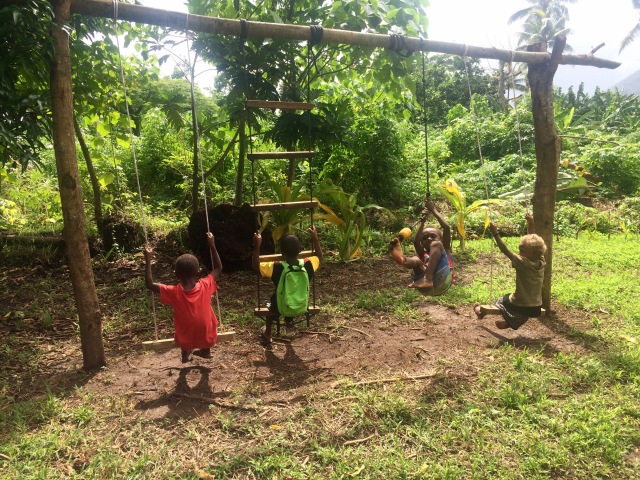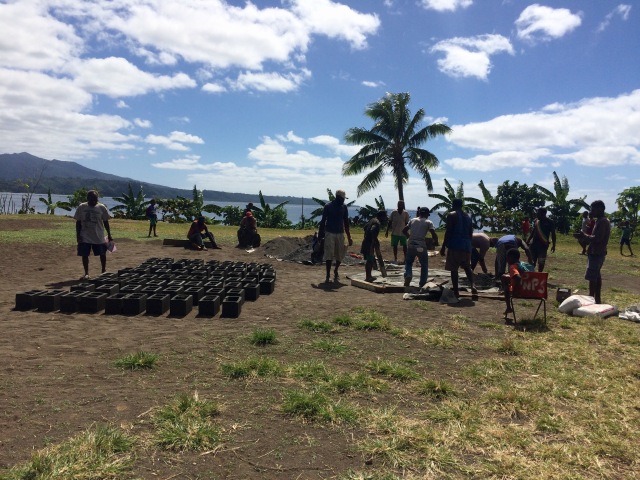The closing ceremony of a Kindy workshop we hosted here in Port Narvin inspired me to introduce to my community the opportunity of applying for a grant through the Peace Corps to fund a large-scale project. Despite some road blocks, we’ve been working hard on a project to replace our school’s benzene-run generator with a solar energy system and get new technologies that could be charged on it. The solar energy system will also provide lights to the classrooms, library, and teacher’s office.
The closing ceremony inspired me because it underscored how motivated my community is to take action towards development and improving education. Many of the community leaders made a point to attend: chiefs, pastors, the headmaster, and the area council secretary. They each gave speeches applauding the kindy teachers for their hard work and emphasizing the importance of a strong educational foundation for our kids and for the future of our island. The area council secretary moved people to tears citing the low statistics in education for Tafea, our province, and Erromango compared to the other islands and inspiring us all to work hard to improve on them.
That the workshop was held at all is a testament to the value our community places on education. Without funding or any obligation, the head kindy teacher and the school council decided to disseminate the information she learned from a workshop through the Ministry of Education to nine kindy teachers from all around North Erromango. This is reflective of how Port Narvin operates. When we hosted an Island-wide economic forum, our village similarly came together to go above and beyond what was required. Among other things, our village built a big stage for the event and a temporarily kitchen and nakamol for the public meals. All the men in the village spent a day in the rain cutting grass and cleaning up the 5 kilometer “road” (really a footpath) through our village. We put on elaborate opening and closing ceremonies including a traditional “custom” dance and string band performances. The management and logistics of the forum give me faith that the community wants and is able to successfully execute and sustain our large-scale project.

Initially, I wasn’t planning to apply for Peace Corps grants for a large-scale community project. The Peace Corps is not an aid organization but a skill-sharing one so that needs to remain our focus, rather than bringing in money, and they warned in training the conflicts that money can create. They also warned that if projects aren’t community driven they usually fall apart before completion. After reflecting on the closing ceremony and economic forum, I felt my community was ready for an ambitious project and mentioning the idea to community leaders confirmed this. They were enthusiastic and told me they already had raised over 100,000 vatu for a community project, an especially large amount considering the size of the local economy, with the previous and first ever Port Narvin Peace Corps volunteers. They also mentioned their interest in a solar energy system for the school. This idea has had unanimous support from everyone I discussed it with.
Our village is remote and rural with limited access to educational resources and a large reliance on benzene-run generators. The teachers and students use paper for everything–grade books, worksheets, lesson planning, things that are more efficiently done on a laptop. We use a generator for as much as ten hours a week to run our copy machine for all this paper. Our community would like to cut down on the paper and benzene use, not just to save money, but, more importantly, because our community, still rebuilding three years after Cyclone Pam, is determined to fight climate change.
Our project, while reducing pollution, simultaneously helps expand the community’s lack of educational resources. With lights, the students could see better on rainy days, teachers could prepare in the evenings and the school council could hold fundraisers and meetings after dark. Despite our remote location, Digicel just installed a 3g network so laptops would allow internet access, greatly expanding knowledge and resources to teachers. One example from this school year illustrates the school’s need for more educational resources. Our school never received the teacher’s guide textbook when the new Reading curriculum for second and third grade came out. During registration this January, the second and third grade teachers requested textbooks and the headmaster had the textbooks sent out on the next ship from Port Vila. It was more than a month until the ship arrived with the new textbooks. Had our school had a laptop or tablet, we could have downloaded the textbooks available for free on the Ministry of Education and Training’s website. This would have not only reduced our need for the paper books, but it also would not have left the teacher’s scrambling for the first month of school. This is just a small example of how these technologies could assist our limited resources while helping fight climate change by reducing our need for paper.
Additionally, we are just finishing a school renovation and construction project, supervised through the Ministry of Education and Training. The community contributed to this project, making 1500 cement blocks and carrying coral and sand to the construction site. All the solar panels and batteries installed would be on brand new roofs and buildings that pass building inspections and should last a long time and that the community is invested in. The new renovation compliments this project and helps ensure sustainability.

Clearly, we’re excited about the project. Serah, a mama and member of the school council, attended a Project Design and Management Workshop with me in the capital, that the Peace Corps organized. They assured us there was plenty of funding for major projects so we got estimates for the solar energy system and technologies and applied for a grant. Serah and I went back and told our community that we were confident we could help complete the funding for the project.
Then I found out funding for the grant program was cut, this year, and only a few projects got partial funding. I was so disappointed but, even more, I hated that we gave the community false hope. They had worked so hard and had raised their financial contribution to the best of their ability.
Luckily, the Peace Corps has another funding option, crowd sourcing through their website. I am so by touched friends and family who have contributed. The Vanuatu Peace Corps office has supported the project through this method too by contributing the entire country fund to it. While we haven’t raised as much money as we were hoping to win in the grant, to me this funding method embodies the true spirit of the Peace Corps. It means so much to my village that so many Americans want to help and have contributed to our project.
For more information on how you can help, https://www.peacecorps.gov/donate/projects/primary-school-technology-solar-project-pp-18-461-001/

Keep up the good work. I donated!
Love,
Aunt Julie
LikeLiked by 1 person
Aww wow, thanks so much Aunt Julie! You’re the best! I’ve told my village about you guys and how Will served in the DR so they’ll be especially touched from your donation!
LikeLike